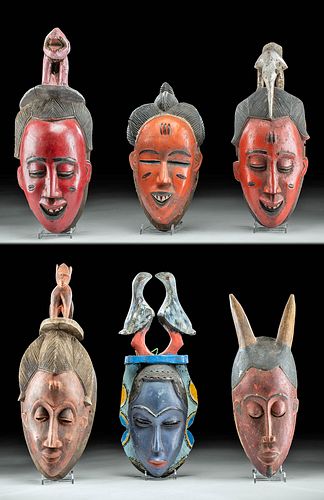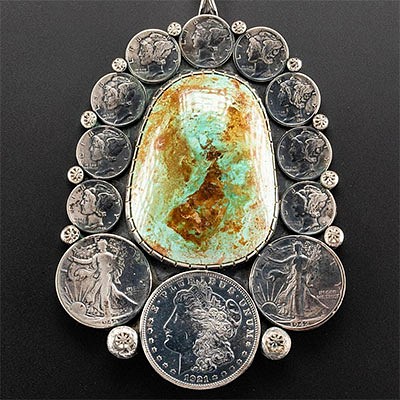Lot of 6 Early 20th C. African Guro Vibrant Wood Masks
Lot 69c
About Seller
Artemis Fine Arts
686 S Taylor Ave, Ste 106
Louisville, CO 80027
United States
Selling antiquities, ancient and ethnographic art online since 1993, Artemis Gallery specializes in Classical Antiquities (Egyptian, Greek, Roman, Near Eastern), Asian, Pre-Columbian, African / Tribal / Oceanographic art. Our extensive inventory includes pottery, stone, metal, wood, glass and textil...Read more
Estimate:
$2,000 - $3,000
Absentee vs Live bid
Two ways to bid:
- Leave a max absentee bid and the platform will bid on your behalf up to your maximum bid during the live auction.
- Bid live during the auction and your bids will be submitted real-time to the auctioneer.
Bid Increments
| Price | Bid Increment |
|---|---|
| $0 | $25 |
| $300 | $50 |
| $1,000 | $100 |
| $2,000 | $250 |
| $5,000 | $500 |
| $10,000 | $1,000 |
| $20,000 | $2,500 |
| $50,000 | $5,000 |
| $100,000 | $10,000 |
| $200,000 | $20,000 |
About Auction
By Artemis Fine Arts
Feb 25, 2021
Set Reminder
2021-02-25 10:00:00
2021-02-25 10:00:00
America/New_York
Bidsquare
Bidsquare : American Frontier | Ethnographic | Tribal Art
https://www.bidsquare.com/auctions/artemis-gallery/american-frontier-ethnographic-tribal-art-6449
Featuring historical examples from the American, Spanish, and Mexican frontiers, as well as Native American, Ethnographic, Tribal, Oceanic, Spanish Colonial, more. All items offered for sale have been legally acquired, are legal to sell and are guaranteed to be as described or your money back. Artemis Fine Arts info@artemisfinearts.com
Featuring historical examples from the American, Spanish, and Mexican frontiers, as well as Native American, Ethnographic, Tribal, Oceanic, Spanish Colonial, more. All items offered for sale have been legally acquired, are legal to sell and are guaranteed to be as described or your money back. Artemis Fine Arts info@artemisfinearts.com
- Lot Description
West Africa, Ivory Coast, Guro culture, ca. early to mid 20th century CE. A remarkable ensemble of six anthropomorphic masks, all featuring slit eyes, broad noses, and petite ears capped by incised, black hair. Three of the vizards boast a high burnish over red-orange paint with open, smiling mouths and ceremonial scarification marks on their cheeks and forehead. Two others are also painted red, but present closed, straight mouths and no scarification. The last visage is enveloped in a vibrant shade of blue with a decorative border of light blue and yellow. Skillfully carved animals, such as birds, a dog, and a monkey, cap the heads of four of the masks, while one of the non-burnished red masks displays two curved horns and a slender goatee. Size: 6.75" W x 19" H (17.1 cm x 48.3 cm)
These masks would have been part of a group of masks considered a family. According to the Metropolitan Museum of Art, "In Guro culture, distinctions are made between masquerades that are the focus of cults and those that are more secular in nature. A sequence of three sacred masks centers around Zamble, a mythical male being whose form fuses antelope and leopard features. He is in turn complemented by his beautiful wife, Gu, and his wild, grotesque brother, Zuali. Such representations are owned by certain families that use them as the loci of sacrificial offerings proposed by diviners to improve their well-being. In contrast, other Guro mask forms, which serve only as sources of entertainment, are designed by individual performers."
Provenance: ex-Phoenicia Holyland Antiquities, New York, New York, USA
All items legal to buy/sell under U.S. Statute covering cultural patrimony Code 2600, CHAPTER 14, and are guaranteed to be as described or your money back.
A Certificate of Authenticity will accompany all winning bids.
We ship worldwide and handle all shipping in-house for your convenience.
#162649Expected surface wear with light nicks/chips and abrasions. Otherwise, intact with lovely earthen deposits throughout and impressive remains of pigments.Condition
- Shipping Info
-
All shipping is handled in-house for your convenience. Your invoice from Artemis Gallery will include shipping calculation instructions. If in doubt, please inquire BEFORE bidding for estimated shipping costs for individual items.
-
- Buyer's Premium



 EUR
EUR CAD
CAD AUD
AUD GBP
GBP MXN
MXN HKD
HKD CNY
CNY MYR
MYR SEK
SEK SGD
SGD CHF
CHF THB
THB

















